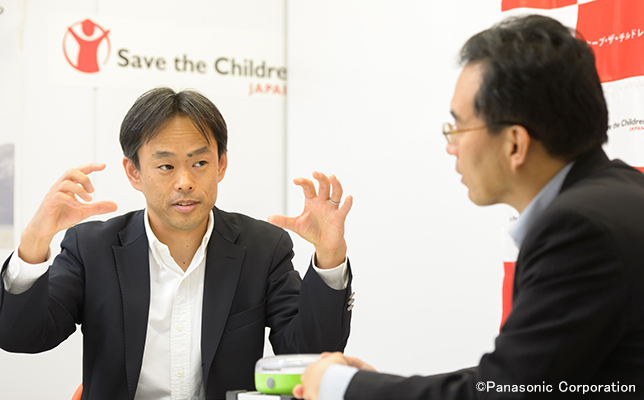2018.01.26Our Partners
Toward an Effective Public-Private Partnerships: UNDP Representative Office in Japan
2015.09.15 Our Partners
Save the Children Japan works to improve health and nutrition for children in Myanmar where under-five mortality rate is high. We spoke with Yasuyuki Fujino, who has recently come back from Myanmar about the situation of child health and solar lantern use (interviewed June 25, 2015).
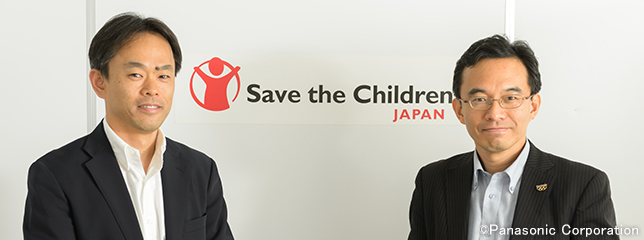
Hoshi : The last time we met was on the occasion of the solar lantern donation ceremony held in Yangon in November last year. I'm so happy to meet you again, this time in Japan. Myanmar has been undergoing a period of dynamic change with political and economic reforms, but since when has Save the Children Japan been active in the country?
Fujino : We established our Myanmar office in 2001, and based on our memorandum of understanding agreed and signed with Myanmar's Ministry of Health, we started our operations in 2003 in collaboration and coordination with local health authorities, especially with local midwives. We implement community-based grass-rooted projects for improving health and nutrition of under-five children and providing care and support for pregnant and postpartum women. I have worked at the Myanmar office for five and a half years since July 2009.
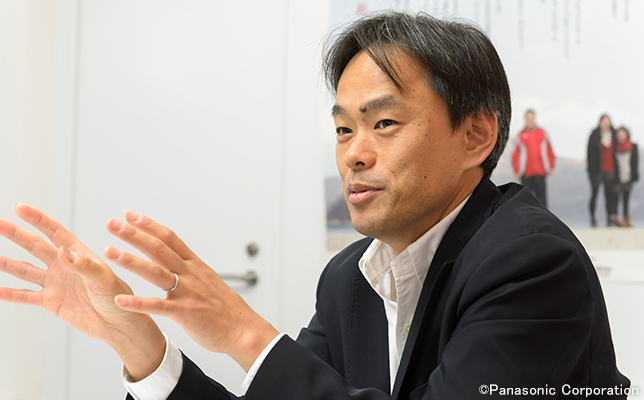
Hoshi : Improving health of under-five children is the fourth goal of the Millennium Development Goals (MDGs) -- to "reduce child mortality." We at Panasonic also recognize this as a critical issue, so we would like to take part in contributing to achieving this goal by donating our products - solar lanterns. Save the Children promotes the rights of children in 120 countries worldwide, but what particularly is the situation in regards to children in Myanmar?
Fujino : The situation is very harsh. The under-five mortality rate is relatively high comparing to other neighboring countries. Child deaths occur particularly in the first 12 months, and the mortality of newborns (within 28 days after birth) accounts for approximately 40% of all the under-five deaths. Preterm birth/low-birth weight accounts for approximately 30% of those deaths while many others are due to infectious diseases like neonatal sepsis. The situation for mothers is as harsh, and according to the "Mothers' Index" (see note) which compares the state of the world's mothers based on five indexes such as "Lifetime risk of maternal death" and "Under-five mortality rate," Myanmar ranks 157th out of 178 countries.
※Ranking in the "State of the World's Mothers" announced by Save the Children every year just in time for Mother's Day.
Hoshi : I see. What about difference in access to health services between urban and rural areas?
Fujino : There have been reports that about 90% of under-five deaths are occurring in rural areas. Additionally, medical professionals such as doctors and midwives attend 90% of births in urban areas whereas this percentage drops to approximately 60% in rural areas. You can see that the disparity in access to health services between areas within the country is a major health issue. Therefore, we have decided to focus on saving the lives of newborns in the rural areas, and to take the approach of continuum of care which looks after both mother and child together throughout from pregnancy, delivery, birth and childhood up to until the age of five.
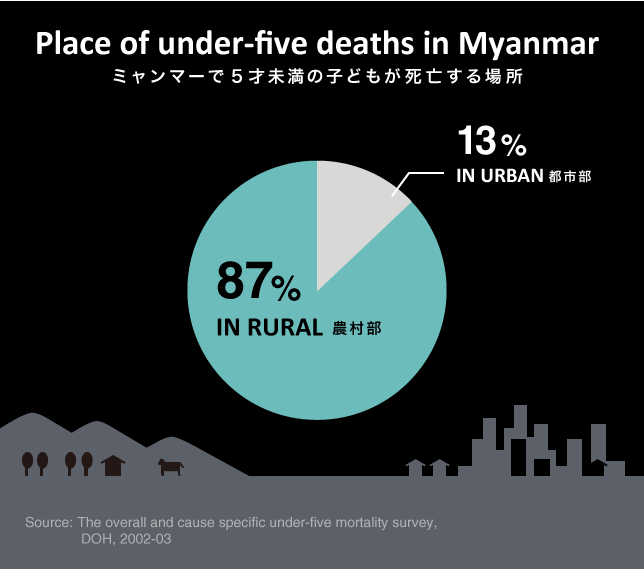
87% of under-five deaths are occurring in rural areas.
Fujino : Rural villages are often located in off-grid areas and most of the areas that we support have no electricity. At night, it is so dark that the light of the moon casts a shadow.
Hoshi : Myanmar's non-electrification rate is 68% for the country overall, and 82% in rural areas, which is particularly high even among its Asian neighbors. It must be very challenging for midwives to assist births in the dark.
Fujino : In the townships where we work, one midwife attends approximately 100 births every year, of which about 80% take place at homes. And in many cases, deliveries occur in the middle of the night. Once a midwife is called, she will sometimes walk for hours in the pitch black to the home of a woman in labor and assist the delivery by the light of a candle or flashlight. However, despite their caution, in many cases, it is difficult to provide adequate care due to lack of light.
When we were trying to come up with a support after hearing about these challenges, we heard about Panasonic's solar lanterns through other NGO working in Myanmar. After hearing an introduction by the representative, we felt this product and its durability could be trusted.
Hoshi : Thank you. And I suppose that's the link to "DeNA Home Run for Life", a collaboration program between Save the Children Japan and DeNA. It is an incredible and innovative program in which one solar lantern is donated for every homerun by Yokohama DeNA Baystars players in official baseball game in Japan.
Fujino : Yes, ever since this project launched, I've gained the new habit of checking the number of homeruns in every game (chuckles).
Hoshi : Actually, I make sure check often too (chuckles). "Home Run for Life" came right at a time when Panasonic was eager to contribute in the area of maternal and child health. We are extremely delighted for the opportunity of our collaboration.
Fujino : The feeling is mutual. In addition to the 190 lanterns donated by DeNA last year, we were able to distribute solar lanterns to 394 midwives working in ten townships.
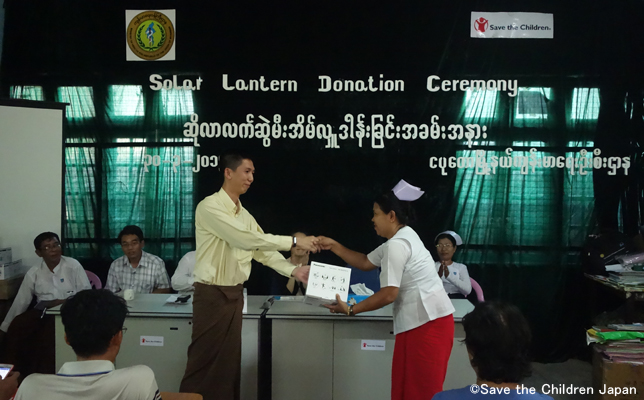
At the donation ceremony, a Save the Children staff member presented a solar lantern to each midwife, followed by a thorough introduction and demonstration of solar lanterns using a manual written in a local language.
Hoshi : How are the midwives using the solar lanterns?
Fujino : It is mainly a source of light when attending births in the night. During home deliveries, of which many occur in not so hygienic conditions and environments, midwives are able to prevent infections by providing adequate delivery, post-natal, and newborn care under a reliable light source. Additionally, the solar lanterns help midwives ward off snakes on roads at night on their way to and from the homes where deliveries take place. They are also used during ante-natal checkups held in homes that are dark even during the day or when writing up reports to township health department in the evening. The midwives favor its portability and durability, and charging them during the day has become their daily routine.
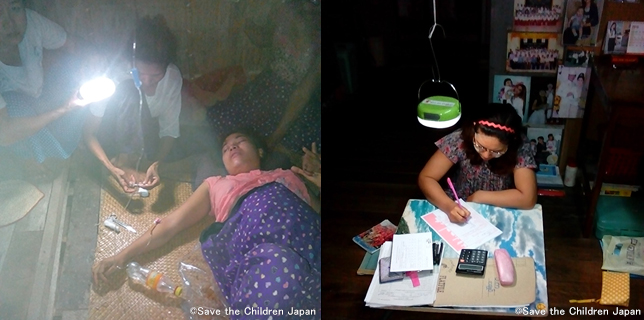
In addition to assisting deliveries, the solar lanterns are also used when writing monthly reports at night.
Fujino : The solar lanterns that watch over new lives coming into this world are a source of enormous reassurance and a light of hope and the future. Myanmar has 330 townships, and approximately 10,000 midwives working there. Many townships still have no electricity so we'd like to distribute as many solar lanterns to these midwives as possible.
Hoshi : I agree. The birth of a new life is a miraculous event, beyond words. And it couldn't make us happier to provide support for that. I hope to work with you again in the future to deliver light to protect the health of pregnant and postpartum women and newborns in areas without electricity.
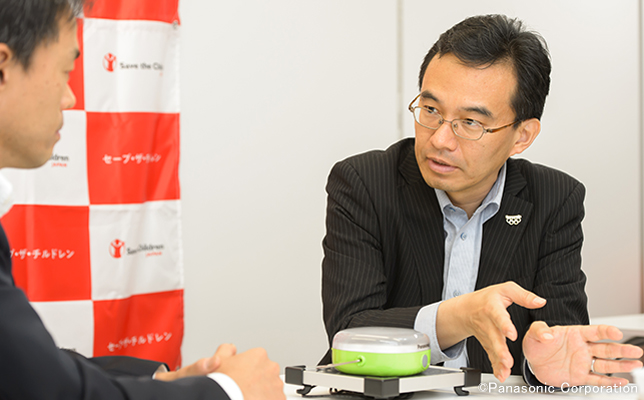
Fujino : Thank you. It seems that Save the Children Japan and Panasonic work in different fields, but I believe that we have three important points in common. First is the universality of our organization principle, second, that this principle of our founders continues to be maintained and passed down through the generations, and third, that we see the entire world as our stage and carry out our activities, on a global scale. These are our greatest strengths. I hope we can continue cooperating with one another while sharing our knowledge, experience and wisdom.
Hoshi : I couldn't agree more. I hope to build on this relationship that we've had the opportunity of creating.
